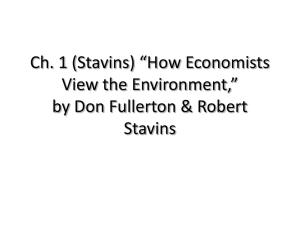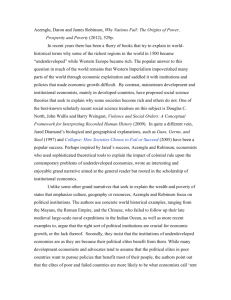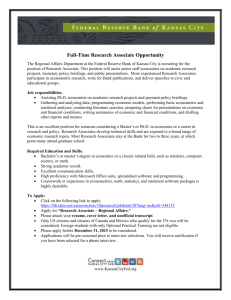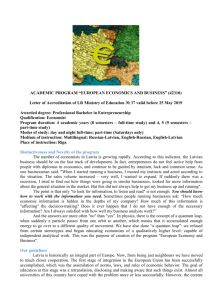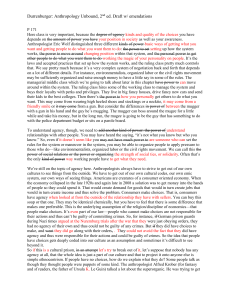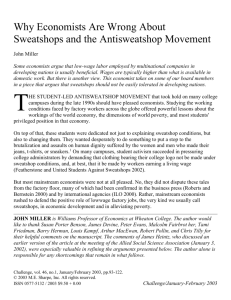The fruits of fieldwork - University of Toronto Scarborough
advertisement
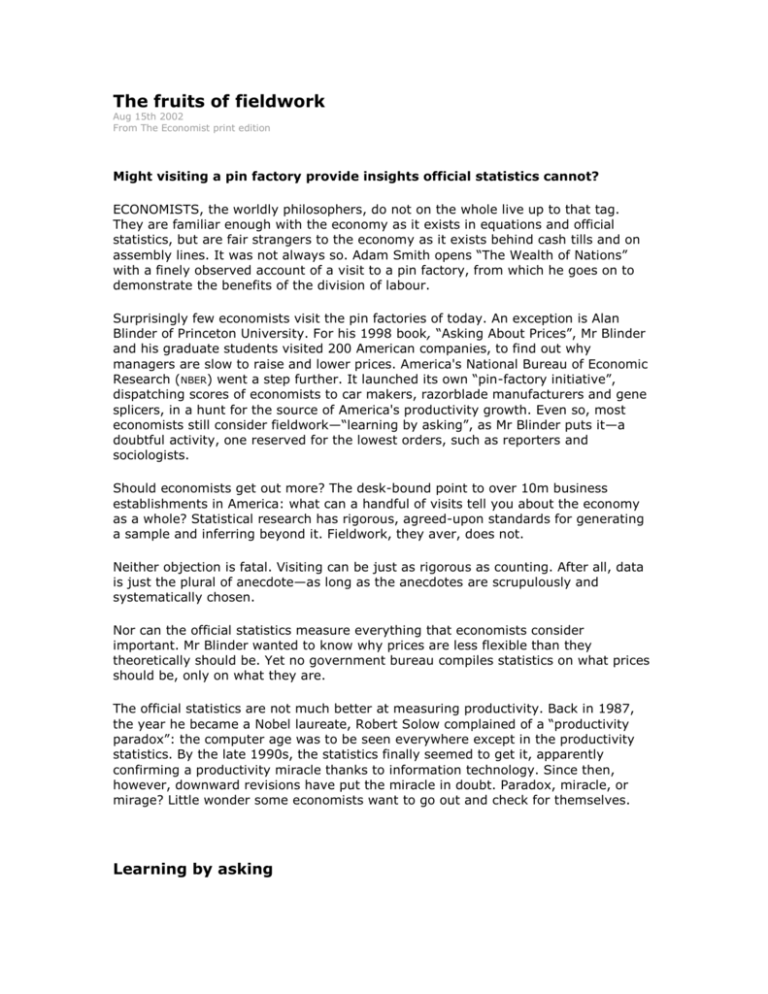
The fruits of fieldwork Aug 15th 2002 From The Economist print edition Might visiting a pin factory provide insights official statistics cannot? ECONOMISTS, the worldly philosophers, do not on the whole live up to that tag. They are familiar enough with the economy as it exists in equations and official statistics, but are fair strangers to the economy as it exists behind cash tills and on assembly lines. It was not always so. Adam Smith opens “The Wealth of Nations” with a finely observed account of a visit to a pin factory, from which he goes on to demonstrate the benefits of the division of labour. Surprisingly few economists visit the pin factories of today. An exception is Alan Blinder of Princeton University. For his 1998 book, “Asking About Prices”, Mr Blinder and his graduate students visited 200 American companies, to find out why managers are slow to raise and lower prices. America's National Bureau of Economic Research (NBER) went a step further. It launched its own “pin-factory initiative”, dispatching scores of economists to car makers, razorblade manufacturers and gene splicers, in a hunt for the source of America's productivity growth. Even so, most economists still consider fieldwork—“learning by asking”, as Mr Blinder puts it—a doubtful activity, one reserved for the lowest orders, such as reporters and sociologists. Should economists get out more? The desk-bound point to over 10m business establishments in America: what can a handful of visits tell you about the economy as a whole? Statistical research has rigorous, agreed-upon standards for generating a sample and inferring beyond it. Fieldwork, they aver, does not. Neither objection is fatal. Visiting can be just as rigorous as counting. After all, data is just the plural of anecdote—as long as the anecdotes are scrupulously and systematically chosen. Nor can the official statistics measure everything that economists consider important. Mr Blinder wanted to know why prices are less flexible than they theoretically should be. Yet no government bureau compiles statistics on what prices should be, only on what they are. The official statistics are not much better at measuring productivity. Back in 1987, the year he became a Nobel laureate, Robert Solow complained of a “productivity paradox”: the computer age was to be seen everywhere except in the productivity statistics. By the late 1990s, the statistics finally seemed to get it, apparently confirming a productivity miracle thanks to information technology. Since then, however, downward revisions have put the miracle in doubt. Paradox, miracle, or mirage? Little wonder some economists want to go out and check for themselves. Learning by asking Can managers in the field explain what the data cannot? Another Nobel prizewinner, Milton Friedman, has long doubted it. For Mr Friedman, economic behaviour owes as much to “market selection” as it does to express intention. Firms maximise profits because, if they did not, they would no longer be in business. Thus a firm's managers may be successful without being very good at explaining the principles underlying their success. A successful manager, in Mr Friedman's eyes, is like an expert billiard player. He can make the cue ball do his bidding, but he cannot explain the physics behind a cannon or a kiss. So did Mr Blinder or the pin-factory economists learn anything new? After hundreds of interviews, Mr Blinder was still unable to declare an outright winner among the competing theories of inflexible prices—though he did narrow the field somewhat. Some of his interviewees were only too reminiscent of Mr Friedman's billiard player, failing to grasp fundamental concepts like the difference between average costs (the cost per unit produced) and marginal costs (the additional cost of producing one more unit). The NBER team also failed to pinpoint the source of the rise in American productivity in the 1990s. At the Ford car plant in Ohio, for example, productivity gains came from simple automation, replacing men with machines. At Toyota's plant in Kentucky, gains came from ergonomics, fitting the machine to the man. One of the more striking impressions was also faintly ironic. Much of the new economy, Robert Gordon of Northwestern University observed, takes place in front of computer screens, in workplaces indistinguishable from the university offices he and his colleagues had escaped from. Still, the economists all felt better for their day out. Edward Lazear of Stanford University was glad of his visit to Safelite Auto Glass. The company's switch from time-rates of pay to piece-rates gave Mr Lazear tangible examples of the link between pay and motivation, examples that stuck in readers' minds long after they had forgotten his statistics. It is, he says, one of his most-cited papers. Maybe these visits are not so different from Adam Smith's. As it happened, he did not discover the division of labour at his pin factory: the concept was already understood by his teacher, Francis Hutcheson. Even his painstaking description of the “18 distinct operations” of pin making was probably cribbed from Diderot's encyclopedia. In short, Smith might well have written his famous passage from his ivory tower at Glasgow University. Yet, as Mr Lazear discovered, even if fieldwork fails to inspire a hypothesis or prove a truth, it can help to sell ideas. The pin factory certainly helped Adam Smith rack up a few citations over the years.
